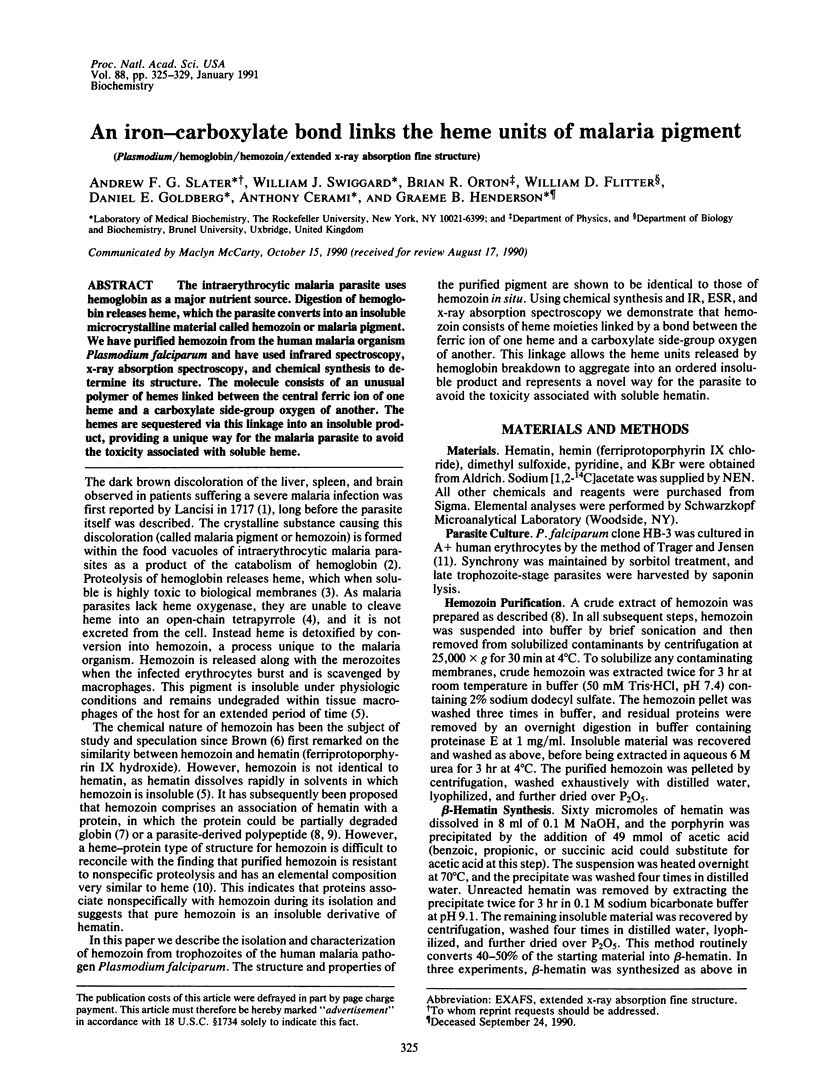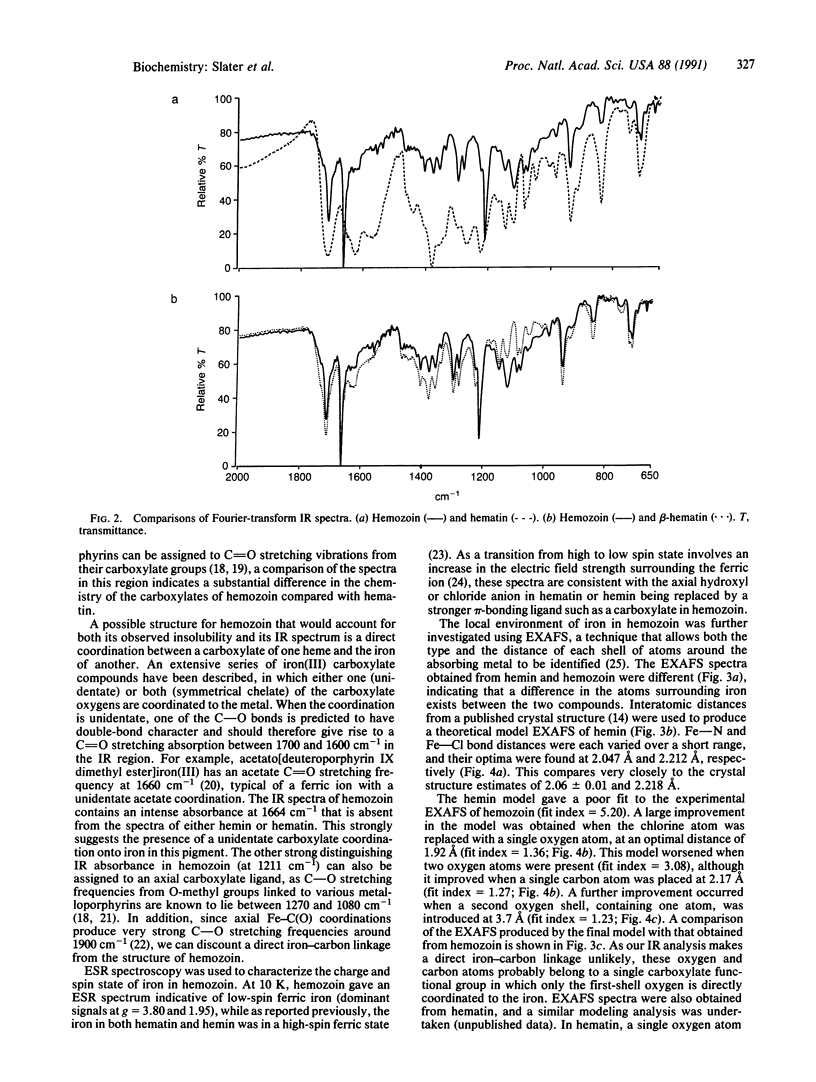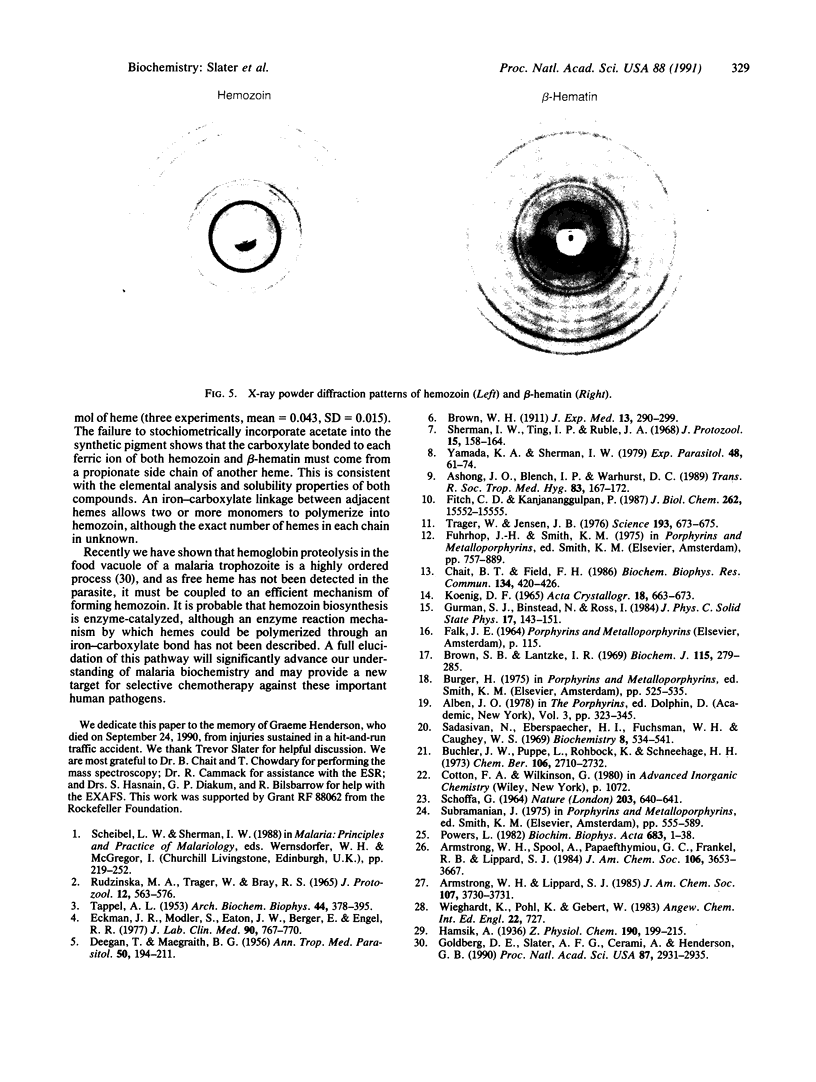Abstract
The intraerythrocytic malaria parasite uses hemoglobin as a major nutrient source. Digestion of hemoglobin releases heme, which the parasite converts into an insoluble microcrystalline material called hemozoin or malaria pigment. We have purified hemozoin from the human malaria organism Plasmodium falciparum and have used infrared spectroscopy, x-ray absorption spectroscopy, and chemical synthesis to determine its structure. The molecule consists of an unusual polymer of hemes linked between the central ferric ion of one heme and a carboxylate side-group oxygen of another. The hemes are sequestered via this linkage into an insoluble product, providing a unique way for the malaria parasite to avoid the toxicity associated with soluble heme.
Full text
PDF




Images in this article
Selected References
These references are in PubMed. This may not be the complete list of references from this article.
- Ashong J. O., Blench I. P., Warhurst D. C. The composition of haemozoin from Plasmodium falciparum. Trans R Soc Trop Med Hyg. 1989 Mar-Apr;83(2):167–172. doi: 10.1016/0035-9203(89)90631-7. [DOI] [PubMed] [Google Scholar]
- Brown S. B., Lantzke I. R. Solution structures of ferrihaem in some dipolar aprotic solvents and their binary aqueous mixtures. Biochem J. 1969 Nov;115(2):279–285. doi: 10.1042/bj1150279. [DOI] [PMC free article] [PubMed] [Google Scholar]
- Chait B. T., Field F. H. A rapid, sensitive mass spectrometric method for investigating microscale chemical reactions of surface adsorbed peptides and proteins. Biochem Biophys Res Commun. 1986 Jan 14;134(1):420–426. doi: 10.1016/0006-291x(86)90580-2. [DOI] [PubMed] [Google Scholar]
- DEEGAN T., MAEGRAITH B. G. Studies on the nature of malarial pigment (haemozion). I. The pigment of the simian species, Plasmodium knowlesi and P. Cynomolgi. Ann Trop Med Parasitol. 1956 Jun;50(2):194–211. doi: 10.1080/00034983.1956.11685759. [DOI] [PubMed] [Google Scholar]
- Eckman J. R., Modler S., Eaton J. W., Berger E., Engel R. R. Host heme catabolism in drug-sensitive and drug-resistant malaria. J Lab Clin Med. 1977 Oct;90(4):767–770. [PubMed] [Google Scholar]
- Fitch C. D., Kanjananggulpan P. The state of ferriprotoporphyrin IX in malaria pigment. J Biol Chem. 1987 Nov 15;262(32):15552–15555. [PubMed] [Google Scholar]
- Goldberg D. E., Slater A. F., Cerami A., Henderson G. B. Hemoglobin degradation in the malaria parasite Plasmodium falciparum: an ordered process in a unique organelle. Proc Natl Acad Sci U S A. 1990 Apr;87(8):2931–2935. doi: 10.1073/pnas.87.8.2931. [DOI] [PMC free article] [PubMed] [Google Scholar]
- KOENIG D. F. THE STRUCTURE OF ALPHA-CHLOROHEMIN. Acta Crystallogr. 1965 Apr 10;18:663–673. doi: 10.1107/s0365110x65001536. [DOI] [PubMed] [Google Scholar]
- Powers L. X-ray absorption spectroscopy. Application to biological molecules. Biochim Biophys Acta. 1982 Sep 1;683(1):1–38. doi: 10.1016/0304-4173(82)90011-8. [DOI] [PubMed] [Google Scholar]
- Rudzinska M. A., Trager W., Bray R. S. Pinocytotic uptake and the digestion of hemoglobin in malaria parasites. J Protozool. 1965 Nov;12(4):563–576. doi: 10.1111/j.1550-7408.1965.tb03256.x. [DOI] [PubMed] [Google Scholar]
- SCHOFFA G. ELECTRON SPIN RESONANCE IN HAEMIN, HAEMATIN AND HAEMOGLOBIN AT 4.2 DEGREES K. Nature. 1964 Aug 8;203:640–641. doi: 10.1038/203640a0. [DOI] [PubMed] [Google Scholar]
- Sadasivan N., Eberspaecher H. I., Fuchsman W. H., Caughey W. S. Substituted deuteroporphyrins. VI. Ligand-exchange and dimerization reactions of deuterohemins. Biochemistry. 1969 Feb;8(2):534–541. doi: 10.1021/bi00830a012. [DOI] [PubMed] [Google Scholar]
- Sherman I. W., Ting I. P., Ruble J. A. Characterization of the malaria pigment (hemozoin) from the avian malaria parasite Plasmodium lophurae. J Protozool. 1968 Feb;15(1):158–164. doi: 10.1111/j.1550-7408.1968.tb02103.x. [DOI] [PubMed] [Google Scholar]
- TAPPEL A. L. The mechanism of the oxidation of unsaturated fatty acids catalyzed by hematin compounds. Arch Biochem Biophys. 1953 Jun;44(2):378–395. doi: 10.1016/0003-9861(53)90056-3. [DOI] [PubMed] [Google Scholar]
- Trager W., Jensen J. B. Human malaria parasites in continuous culture. Science. 1976 Aug 20;193(4254):673–675. doi: 10.1126/science.781840. [DOI] [PubMed] [Google Scholar]
- Yamada K. A., Sherman I. W. Plasmodium lophurae: composition and properties of hemozoin, the malarial pigment. Exp Parasitol. 1979 Aug;48(1):61–74. doi: 10.1016/0014-4894(79)90055-9. [DOI] [PubMed] [Google Scholar]




